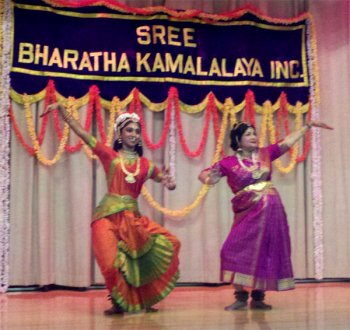
|   |

|   |
Kamala presents dance drama ‘Jaya Jaya Sree Rama’ - Uma Dandapani e-mail: uma.dandapani29@gmail.com December 28, 2012 Evoking memories of a time when she imparted an allure and unique appeal to her idiom, Padma Bhushan and 2010 NEA National Heritage artiste Kamala Lakshminarayanan, the legendary Bharatanatyam artiste who was popularly known as ‘Kumari Kamala’ in the early days of her career, performed in a dance drama titled ‘Jaya Jaya Sree Rama’ based on the Ramayana. The performance was held in a school auditorium in Floral Park, New York City, in late November this year.  Choreographed by Guru Kamala, vignettes from the Bala Kandam and the Ayodhya Kandam were presented by students of Sree Bharatha Kamalalaya, Kamala’s dance school based in New York. The program began with the traditional Vazhuvoor Thodayamangalam followed by a curtain raiser ‘Jaya Jaya Rama’ based on Annamacharya’s composition in ragam Behag set to adi talam, performed by Rubica and Pooja Aier. A padam “Sri Mahalakshmi Jagan Matha” was performed by Kamala in ragam Sankarabharanam and misra chapu talam, composed by Papanasam Sivan, to a recorded rendition by vocalist T.V. Sankaranarayanan. Dressed in a brocaded magenta dance sari, the veteran artiste seemed transformed into the resplendent goddess of prosperity, emerging from the Ocean of Milk with the words “Par kadal tharum Krupakari” and with “Pankaja malar valar annaye” as she depicted the deity ensconced in the whorls of a lotus, with the twirling motions of the alapadmam. A Pushpanjali was presented by senior student Pallavi Moorthy and Pooja Aier in ragam Vijaya Vasantham, set to adi talam, composed by Madurai Muralidharan to recorded music by vocalist O.S. Arun. The presentation of the dance drama by Sree Bharatha Kamalalaya was based on music and songs composed by 18th century Tamil poet Arunachala Kavirayar, in which Kamala performed two dances in the opening scenes as King Dasaratha. The music was presented by a dance orchestra comprising local artists. Dedicating the show to her mother Rajammal, Kamala’s intricate choreography shone with the hallmarks of the Vazhuvoor style: a flowing sequence of adavus, richly ornamented jati korvais and vibrant rhythms, all of which were enhanced with subtle but evocative bhava. In the song, “Ramanai Tharuvaaye” in ragam Dwijavanthi and misra chapu talam, Kamala displayed finesse in her portrayal of the king resisting the persuasions of Sage Viswamitra, as the latter sought the help of the young princes Rama and his siblings in battling the demons of the Dandaka forest. The song “Raman Edhukku” in ragam Sunada Vinodini and misra chapu talam continued in this vein with Kamala as King Dasaratha, conveying with fluid abhinaya, the concerns of a reluctant father and monarch at the prospect of sending his young princes to battle the demons. Kamala’s student Komal Keerthy aptly expressed the gravitas of Viswamitra with her performance as the persistent ascetic, while matching her guru’s rhythmic precision with her footwork. The protagonist was played by Pooja Aier who depicted Rama, composed in his demeanor, yet enamored as he beheld Sita in the padam “Yaaro Ivar Yaaro” in ragam Bhairavi, adi talam. Pallavi Moorthy as Sita portrayed a beseeching wife seeking to accompany Rama during his banishment in the padam “Eppadi Manam Thuninthatho Swami” in ragam Huseini, misra chapu talam. The swagger and deflated ego of the demon king Ravana, who was unsuccessful in lifting Shiva’s bow at Sita’s swayamvara, was conveyed in an expressive performance by Poorni Arunachalam, who also played the part of an anguished King Dasaratha as he pleaded with an obdurate Queen Kaikeyi against the banishment of Rama. Rucha Acharya ably performed as Kaikeyi, initially expressing her admiration for Rama with “Ramannuku mannan mudi taritaaley” in ragam Hindolam and adi talam, in response to news of the coronation from Mandara, whose role was presented by Sruthi Sridevan. Lakshmana’s simmering anger over the unjust banishment of his brother Rama was convincingly presented by Shreya Desikan in “Naaney Lakshmanar” in ragam Atana set to adi talam, with rapid footwork that seemed to add emphasis to the emotion. Ambika Venkatakrishnan depicted Ahalya, who was redeemed from her curse. The orchestra for the dance drama included vocalists Sandhya Manjunatha and Kamini Dandapani, whose strong and expressive singing added fullness to the dimension of the characters portrayed; T.V Krishna’s nattuvangam lent sparkle to Kamala’s choreography; Sandhya Anand’s mellow violin accompaniment was a perfect foil to the vocalists, while mridangam artist Murali Balachander’s rhythmic competence anchored the orchestral support. To conclude the performance, a Thillana was presented as a group performance in ragam Palini set to adi talam, composed by Madurai Muralidharan, to a recorded rendition by vocalist O.S. Arun. Other segments of the Ramayana were presented by local artists including a Kathak performance of ‘Mareecha Vatham’ by Sowmya Viswanath, ‘Sabari Pratheeksha’ in Kuchpudi by Sadhana Paranji and students and the Sundar Kand in Odissi by Mala Desai and students. Uma Dandapani is a freelance journalist, whose articles over the past 27 years have been carried by many leading publications. |